Pantograph
A pantograph (Greek roots παντ- "all, every" and γραφ- "to write", from their original use for copying writing) is a mechanical linkage connected in a manner based on parallelograms so that the movement of one pen, in tracing an image, produces identical movements in a second pen. If a line drawing is traced by the first point, an identical, enlarged, or miniaturized copy will be drawn by a pen fixed to the other. Using the same principle, different kinds of pantographs are used for other forms of duplication in areas such as sculpture, minting, engraving, and milling.
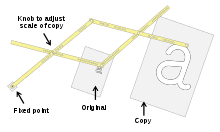

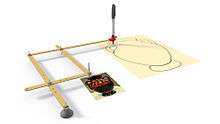
Because of the shape of the original device, a pantograph also refers to a kind of structure that can compress or extend like an accordion, forming a characteristic rhomboidal pattern. This can be found in extension arms for wall-mounted mirrors, temporary fences, scissor lifts, and other scissor mechanisms such as the pantograph used on electric locomotives and trams.
History
The ancient Greek engineer Hero of Alexandria in his work Mechanics, described pantographs.[1]
In 1603,[2] Christoph Scheiner used a pantograph to copy and scale diagrams, and wrote about the invention over 27 years later, in "Pantographice" (Rome 1631).[3] One arm of the pantograph contained a small pointer, while the other held a drawing implement, and by moving the pointer over a diagram, a copy of the diagram was drawn on another piece of paper. By changing the positions of the arms in the linkage between the pointer arm and drawing arm, the scale of the image produced can be changed.
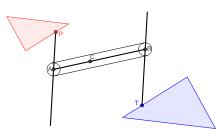
In 1821, Professor William Wallace (1768–1843) invented the eidograph to improve upon the practical utility of the pantograph.[4] The eidograph relocates the fixed point to the center of the parallelogram and uses a narrow parallelogram to provide improved mechanical advantages.
Uses
Drafting
The original use of the pantograph was for copying and scaling line drawings. Modern versions are sold as toys.
Sculpture and minting
Sculptors use a three-dimensional version of the pantograph,[5] usually a large boom connected to a fixed point at one end, bearing two rotating pointing needles at arbitrary points along this boom. By adjusting the needles different enlargement or reduction ratios can be achieved. This device, now largely overtaken by computer guided router systems that scan a model and can produce it in a variety of materials and in any desired size,[6] was invented by inventor and steam pioneer James Watt (1736–1819) and perfected by Benjamin Cheverton (1796–1876) in 1836. Cheverton's machine was fitted with a rotating cutting bit to carve reduced versions of well-known sculptures.[7] A three-dimensional pantograph can also be used to enlarge sculpture by interchanging the position of the model and the copy.[8][9]
Another version is still very much in use to reduce the size of large relief designs for coins down to the required size of the coin.[10]
Acoustic cylinder duplication
One advantage of phonograph and gramophone discs over cylinders in the 1890s—before electronic amplification was available—was that large numbers of discs could be stamped quickly and cheaply. In 1890, the only ways of manufacturing copies of a master cylinder were to mold the cylinders (which was slow and, early on, produced very poor copies), to record cylinders by the "round", over and over again, or to acoustically copy the sound by placing the horns of two phonographs together or to hook the two together with a rubber tube (one phonograph recording and the other playing the cylinder back). Edison, Bettini, Leon Douglass and others solved this problem (partly) by mechanically linking a cutting stylus and a playback stylus together and copying the "hill-and-dale" grooves of the cylinder mechanically. When molding improved somewhat, molded cylinders were used as pantograph masters. This was employed by Edison and Columbia in 1898, and was used until about January 1902 (Columbia brown waxes after this were molded). Some companies like the United States Phonograph Co. of Newark, New Jersey, supplied cylinder masters for smaller companies so that they could duplicate them, sometimes pantographically. Pantographs could turn out about 30 records per day and produce up to about 150 records per master. In theory, pantograph masters could be used for 200 or 300 duplicates if the master and the duplicate were running in reverse and the record would be duplicated in reverse. This, in theory, could extend the usability of a pantograph master by using the unworn/lesser worn part of the recording for duplication. Pathé employed this system with mastering their vertically-cut records until 1923; a 5-inch-diameter (130 mm), 4-or-6-inch-long (100 or 150 mm) master cylinder, rotating at a high speed, would be recorded on. This was done as the resulting cylinder was considerably loud and of very high fidelity. Then, the cylinder would be placed on the mandrel of a duplicating pantograph that would be played with a stylus on the end of a lever, which would transfer the sound to a wax disc master, which would be electroplated and be used to stamp copies out. This system resulted in some fidelity reduction and rumble, but relatively high quality sound. Edison Diamond Disc Records were made by recording directly onto the wax master disc.
Milling machines
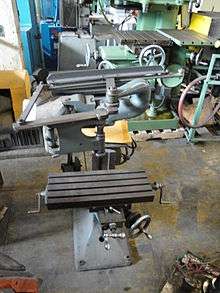
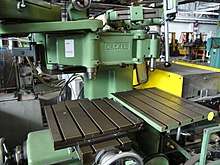
Before the advent of control technologies such as numerical control (NC and CNC) and programmable logic control (PLC), duplicate parts being milled on a milling machine could not have their contours mapped out by moving the milling cutter in a "connect-the-dots" ("by-the-numbers") fashion. The only ways to control the movement of the cutting tool were to dial the positions by hand using dexterous skill (with natural limits on a human's accuracy and precision) or to trace a cam, template, or model in some way, and have the cutter mimic the movement of the tracing stylus. If the milling head was mounted on a pantograph, a duplicate part could be cut (and at various scales of magnification besides 1:1) simply by tracing a template. (The template itself was usually made by a tool and die maker using toolroom methods, including milling via dialing followed by hand sculpting with files and/or die grinder points.) This was essentially the same concept as reproducing documents with a pen-equipped pantograph, but applied to the machining of hard materials such as metal, wood, or plastic. Pantograph routing, which is conceptually identical to pantograph milling, also exists (as does CNC routing). The Blanchard lathe, a copying lathe developed by Thomas Blanchard, used the same essential concept.
The development and dissemination throughout industry of NC, CNC, PLC, and other control technologies provided a new way to control the movement of the milling cutter: via feeding information from a program to actuators (servos, selsyns, leadscrews, machine slides, spindles, and so on) that would move the cutter as the information directed. Today most commercial machining is done via such programmable, computerized methods. Home machinists are likely to work via manual control, but computerized control has reached the home-shop level as well (it's just not yet as pervasive as its commercial counterparts). Thus pantograph milling machines are largely a thing of the past. They are still in commercial use, but at a greatly reduced and ever-dwindling level. They are no longer built new by machine tool builders, but a small market for used machines still exists. As for the magnification-and-reduction feature of a pantograph (with the scale determined by the adjustable arm lengths), it is achieved in CNC via mathematic calculations that the computer applies to the program information practically instantaneously. Scaling functions (as well as mirroring functions) are built into languages such as G-code.
Other uses
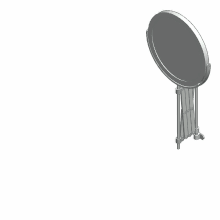
Perhaps the pantograph that is most familiar to the general public is the extension arm of an adjustable wall-mounted mirror.
In another application similar to drafting, the pantograph is incorporated into a pantograph engraving machine with a revolving cutter instead of a pen, and a tray at the pointer end to fix precut lettered plates (referred to as 'copy'), which the pointer follows and thus the cutter, via the pantograph, reproduces the 'copy' at a ratio to which the pantograph arms have been set. The typical range of ratio is Maximum 1:1 Minimum 50:1 (reduction) In this way machinists can neatly and accurately engrave numbers and letters onto a part. Pantographs are no longer commonly used in modern engraving, with computerized laser and rotary engraving taking favor.
The device which maintains electrical contact with the contact wire and transfers power from the wire to the traction unit, used in electric locomotives and trams, is also called a "pantograph".
Some types of trains on the New York City Subway use end pantograph gates (which, to avoid interference, compress under spring pressure around curves while the train is en route) to prevent passengers on station platforms from falling into or riding in the gaps between the cars.
Some commercial vehicles have windscreen wipers on pantographs to allow the blade to cover more of the windscreen on each wipe.
Old-style 'baby gates' used a 2-dimensional pantograph mechanism (in a similar style to pantograph gates on subway cars) as a means of keeping toddlers away from stairways. The openings in these gates are too large to meet modern baby gate safety standards.
Herman Hollerith's "Keyboard punch" used for the 1890 U.S. Census was a pantograph design and sometimes referred to as "The Pantograph Punch".[11]
An early 19th-century device employing this mechanism is the polygraph, which produces a duplicate of a letter as the original is written.
In churches in many countries (generally before modern animal welfare), dog whippers used 'dog tongs' with a pantograph mechanism to control dogs at a distance.
| Wikimedia Commons has media related to Pantographs (instrument). |
Fools in German carnivals use stretching shears ("Streckschere"), a.k.a. Nürnberger Scissors (de:Nürnberger Schere) as hat snatchers to entertain the crowds.
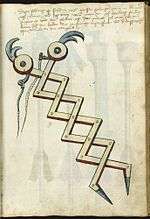
The fencing and swordsmanship manual Ms.Thott.290.2º written in 1459 by Hans Talhoffer includes what appears to be an extending blade working on the same principle.
In 1886, Eduard Selling patented a prize-winning calculating machine based on the pantograph, although it was not commercially successful.[12]
In many cartoons, the bird in a cuckoo clock is depicted as extending on a pantograph mechanism, although this is seldom the case in actual clocks.
Expanding fences or trellises use folding pantograph mechanisms, for ease of transport and storage.
Longarm quilting machine operators may trace a pantograph, paper pattern, with a laser pointer to stitch a custom pattern onto the quilt. Digitized pantographs are followed by computerized machines.
Linn Boyd Benton invented a pantographic engraving machine for type design,[13] which was capable not only of scaling a single font design pattern to a variety of sizes, but could also condense, extend, and slant the design (mathematically, these are cases of affine transformation, which is the fundamental geometric operation of most systems of digital typography today, including PostScript).
Pantographs are also used as guide frames in heavy-duty applications including scissor lifts, material handling equipment, stage lifts and specialty hinges (such as for panel doors on boats and airplanes).
Richard Feynman used the analogy of a pantograph as a way of scaling down tools to the nanometer scale in his talk There's Plenty of Room at the Bottom.
Numerous trade-show displays use 3-dimensional pantograph mechanisms to support backdrops for exhibit booths. The framework expands in 2 directions (vertical and horizontal) from a bundle of connected rods into a self-supporting structure on which a fabric backdrop is hung.[14]
See also
- Autopen
- Parallel motion by James Watt
- Spirograph
- Lettering guide
References
- Ceccarelli, Marco (2007). Distinguished Figures in Mechanism and Machine Science: Their Contributions and Legacies. Springer. p. 230. ISBN 978-1-4020-6366-4.
- Van Helden, Albert (1995). "The Galileo Project — Scheiner, Christoph" (history)". Galileo Project, Rice University. Archived from the original on 9 July 2004. Retrieved 24 March 2020.
Between 1603 and 1605 he invented the pantograph, an instrument for copying plans on any scale. He invented a machine helioscopique which allowed measurements, especially of sun spots
- The full title of "Pantographice" is "Pantographice seu Ars delineandi res quaslibet per parallelogrammum lineare seu cavum" (Rome 1631).
- "Transactions of the Royal Society of Edinburgh. - Edinburgh, Dickson 1788-1905". Transactions of the Royal Society of Edinburgh. Dickson. 13: 418–439, 637. 1836.
The Pantograph has no defect in its geometrical principles, but, considered as an instrument for practice, it is by no means perfect. It is composed of metallic bars, which turn on five centres ; it is supported on six rollers turning also on centres, and continually changing their direction while they move along the paper ; and when the instrument is used, the force which changes its figure is in some positions applied obliquely, and thus acts at a disadvantage. In the summer of the year 1821, my attention was directed to copying instruments. I found that the Pantograph was then the only one used, and I formed the resolution of attempting to invent a new instrument, which should be free from its imperfections. … The Eidograph has been shewn (sic) to every ingenious person who has visited me since 1821,
- "An Unfinished Symphony In Stone: A video with sculptor CS Jagger using a three-dimensional pantograph". British Pathé. 28 January 1935. 1 min. 7 sec. Retrieved 24 March 2020.
A wooden framework, approximating to the proportions, was built with this ingenious type of pantograph, which conveyed the outline from the quarter size model...Then Mr. Jagger's pantograph came into action again. Every little contour from the previous model was transferred by pegs, inserted into the larger model at their correct and varied heights.
- Castro, Jan Garden (January–February 2003). "Making the Personal Monumental: A Conversation with Patricia Cronin". Sculpture. International Sculpture Center. 22 No. 1. Archived from the original on 1 October 2019. Retrieved 23 August 2017.
[W]e fabricated this piece using the newest digital technology, a five-axis milling machine at Johnson Atelier in Mercerville, New Jersey. They bought a brand-new machine from Milan specifically to carve this piece—it’s the second one built in the world. The machines are called CNC—Computer Numerically Controlled carving machines. The coupling of 21st-century technology with marble, ..., we 3D-scanned my two-thirds scale plaster to program the milling machine to do complex carving.
- "The man who brought marble sculpture down to size - WriteAntiques". writeantiques.com. Archived from the original on 23 August 2017. Retrieved 23 August 2017.
- "Enlarging and Reducing Sculpture". www.keropiansculpture.com. Retrieved 23 August 2017.
- "Enlarging a copy of the Statue of Liberty (French) by means of a 3d-pantograph with a scanning wheel and a cutting edge, in clay". Archived from the original on 16 July 2004. Retrieved 23 August 2017.
- Androulakis, Ioannis. "Designing and minting coins". www.fleur-de-coin.com. Retrieved 23 August 2017.
- Truesdell, Leon E. (1965). The Development of Punch Card Tabulation in the Bureau of the Census: 1890-1940. US GPO.
- Selling, E. (1887). Eine neue Rechenmaschine. Berlin. doi:10.3931/e-rara-18446.
- Cost, Patricia. (2011). The Bentons: How an American Father and Son Changed the Printing Industry. Rochester, NY. ISBN 978-1-933360-42-3.
- "Archived copy". Archived from the original on 2013-01-16. Retrieved 2013-05-01.CS1 maint: archived copy as title (link)

